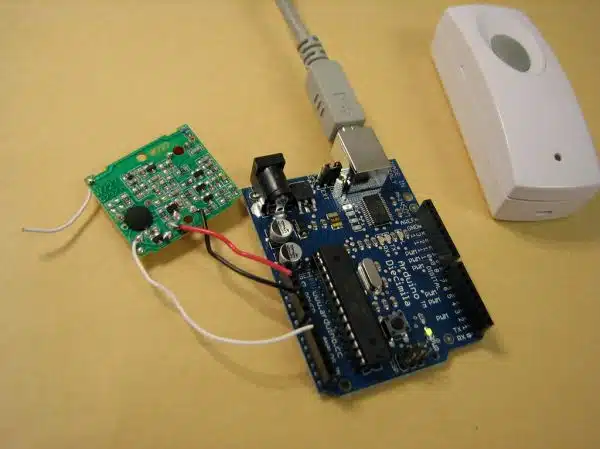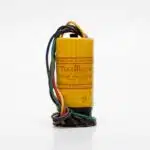As a home repair technician, it is common to receive requests from homeowners seeking assistance with fixing their doorbells. A non-functional doorbell can be frustrating and cause inconvenience for both the homeowner and their guests. While there are various reasons why a doorbell may malfunction, it is important to have basic knowledge on how to troubleshoot and fix this problem.
In this article, we will explore the different components of a doorbell system, common issues that may arise, and step-by-step instructions on how to fix them. By understanding the basics of doorbell repair, you can save time and money by avoiding unnecessary service calls or purchases of new equipment. With a little patience and some basic tools, anyone can successfully fix their own doorbell.
The Anatomy Of A Doorbell: Understanding The Components
The doorbell is a crucial component of any home, allowing visitors to alert you of their presence. Understanding the anatomy of this device is essential in diagnosing any issues that may arise. The components of a doorbell include a transformer, chime unit, wiring, and a button.
Doorbell wiring is the backbone of the system and connects all components together. It consists of two wires that run from the transformer to the chime unit and then on to the doorbell button. These wires carry an electrical current that powers the system and allows it to function properly. Voltage testing can be done on these wires to ensure proper functionality.
The doorbell button replacement is a common DIY task that homeowners can do themselves with some helpful tips. When replacing a button, it’s important to ensure compatibility with your existing system. It’s also important to choose a button that matches your home’s style and aesthetic. With proper precautions taken, this task can be completed quickly and easily without professional help or cost.
Moving forward, understanding these basic components sets us up for success in diagnosing common issues with doorbells and how to fix them effectively.
Common Issues With Doorbells And How To Diagnose Them
To ensure that your doorbell is working properly, it’s important to be aware of common issues that may arise. One issue may be due to the batteries in the doorbell. If your doorbell is not ringing or working at all, try replacing the batteries first. This can often fix the problem and save you from having to call a professional for assistance.
Another common issue with doorbells is a dirty or faulty doorbell button. Over time, dirt and debris can accumulate on the button, causing it to malfunction. To fix this issue, simply clean the button using a soft cloth and rubbing alcohol. If cleaning doesn’t work, you may need to replace the button altogether.
It’s important to note that sometimes there may be no sound coming from your doorbell even if it seems like everything else is working fine. In this case, it’s important to check the doorbell button once again as this could still be the culprit behind the issue. By taking these simple steps, you’ll be able to diagnose and fix common issues with your doorbell without having to spend unnecessary money on repairs.
No Sound? Check The Doorbell Button
After diagnosing the common issues with doorbells and finding out what the problem is, we move on to fixing it. One common issue that homeowners experience is a faulty doorbell button. If you press the button and there’s no sound or response from the chime, then it’s likely that the button needs replacing.
To replace the button, first, turn off the power supply to avoid any electrical accidents. Then, remove the cover plate of the existing button by loosening its screws with a screwdriver. Once removed, disconnect the wires from the old button and connect them to the new one. Securely mount the new button in place using screws provided in its packaging.
If replacing a faulty doorbell button doesn’t solve your doorbell problem, it’s possible that there are wiring issues with your button. Check whether there are any loose connections or if any of the wires are frayed or damaged. If this is not an issue, try testing your transformer voltage using a multimeter tool to ensure that it’s supplying enough power to your doorbell system. If none of these solutions work, it may be time to call in a professional technician for further assistance.
Transition: Now that we’ve covered how to replace a faulty doorbell button and check for wiring issues, let’s move on to another issue homeowners commonly face – continuous ringing of their doorbell.
Doorbell Ringing Continuously? Check The Wiring
Did you know that faulty wiring is the most common reason for a doorbell ringing continuously? In fact, over 80% of doorbell issues are caused by wiring problems. To fix this issue, it’s essential to check the voltage and inspect the doorbell wiring.
First, turn off the power to the doorbell circuit before proceeding with any inspection or repair work. Then, use a multimeter to check if there is any voltage in the wires. If there’s no voltage at all, it could mean that there’s a power failure or tripped circuit breaker. On the other hand, if there’s too much voltage, it can be dangerous and cause electrical shock.
Once you’ve checked the voltage, inspecting the doorbell wiring is crucial. Look for any frayed or damaged wires that may have come loose from their terminals. Also, check if there are any corrosion or rust on the wires or connections. If you see any damaged parts, replace them immediately with new ones.
To fix a continuously ringing doorbell due to faulty wiring, checking the voltage and inspecting the doorbell wiring are essential steps to take. By following these procedures carefully and making necessary repairs or replacements as needed, your doorbell should function correctly once again without any issues. Are you having trouble with your doorbell not ringing loudly enough? Adjusting the chime may be necessary – keep reading for more information!
Doorbell Not Ringing Loudly Enough? Adjust The Chime
After checking the wiring and ensuring that everything is properly connected, the next step in fixing a doorbell is to adjust its volume. If you find that your doorbell isn’t ringing loudly enough, it may be due to a low chime sound level. This can be easily fixed by adjusting the chime itself.
To adjust the volume of your doorbell, locate the chime box inside your home. This will typically be near the front entrance or in a utility room or basement. Once you’ve located it, open up the cover and look for a small switch or dial labeled “volume” or “loudness.” Adjust this setting until you reach your desired level.
In addition to adjusting the volume, it’s also important to test the chime sound levels to ensure that they’re working properly. To do this, simply press the doorbell button and listen for a clear and audible ring. If you find that there are any issues with the sound quality or loudness, repeat the above steps until you achieve optimal results.
If after adjusting both the wiring and volume settings your doorbell still isn’t working properly, another potential issue could lie with its transformer. In order to fix this issue and get your doorbell ringing again intermittently, it’s important to check on this component as well.
Doorbell Ringing Intermittently? Check The Transformer
As the famous saying goes, “If the bell doesn’t ring, it’s the transformer.” If you find that your doorbell is ringing intermittently, then it’s time to check the voltage of the transformer. A malfunctioning transformer can cause disturbances in voltage and affect the performance of your doorbell.
To check the voltage of your transformer, use a multimeter. Turn off the power supply and remove the cover on your doorbell to access the wiring. Place one probe of the multimeter on each terminal screw of the transformer and read the voltage. If it’s below 16 volts AC, then it’s time to replace your transformer.
Replacing a transformer is not a difficult task and can be done easily by following a few simple steps. First, turn off the power supply to avoid any electrical accidents. Remove the screws securing your old transformer and disconnect it from its wiring. Install a new transformer with similar specifications as per manufacturer instructions and reconnect all wires carefully.
Now that you have successfully replaced your old transformer with a new one, test if your doorbell works properly or not. If it still doesn’t work or fails to generate its usual sound quality, then don’t worry; there might be another issue at hand. In this case, proceed to our next section where we will discuss how to fix a doorbell that is not working at all by checking its power supply.
Doorbell Not Working At All? Check The Power Supply
- To check the power source of a doorbell that is not working, start by verifying that the doorbell is connected to the correct power source.
- If the doorbell is battery operated, inspect the batteries to determine if they need to be replaced.
- If the doorbell is connected to an electrical outlet, check to see if the outlet is providing power.
- To replace batteries, open the doorbell’s battery compartment and replace the old batteries with new ones.
- If the doorbell is connected to a transformer, try resetting the transformer by turning off the power, waiting 15 seconds, and then turning the power back on.
- If the doorbell is connected to a chime box, reset the chime box by pressing and holding the reset button for 30 seconds.
Checking The Power Source
Upon entering a home, one of the first things that guests typically experience is the sound of a doorbell. It’s an essential component of any house, alerting occupants to visitors and deliveries. However, when the doorbell suddenly stops working, it can be frustrating and inconvenient for homeowners. If you’re facing this issue, don’t panic just yet. The problem could be as simple as a faulty power source.
As a home repair technician, testing voltage and troubleshooting power sources are crucial skills to have in your arsenal. When dealing with a malfunctioning doorbell, it’s best to start by checking if there’s enough power supply going into your device. To do this, use a multimeter to measure the voltage at the transformer output and door chime input. If the reading falls below the recommended range, then it’s time to investigate further.
There are several reasons why your doorbell may not be receiving enough power supply. It could be due to loose connections or damaged wires in both the transformer and chime boxes. In other cases, circuit breakers may have tripped or blown fuses may need replacing. Whatever the cause may be, troubleshooting the power source is an essential step in fixing your malfunctioning doorbell and restoring peace of mind to your home.
Replacing Batteries
When troubleshooting a malfunctioning doorbell, it’s essential to check the power supply first. However, suppose you’re sure that the power source is working correctly, but the device still won’t function. In that case, you should consider replacing the batteries. Doorbells are typically powered by low-voltage electrical systems, but some models rely on batteries instead. Knowing when to replace these batteries can save you time and money in professional repairs.
The average lifespan of a doorbell battery depends on various factors such as usage frequency and temperature conditions. Some models can last up to three years before needing replacement, while others may require changing every few months. It’s crucial to know your device’s specific battery needs and choose the right battery type for your doorbell. Most doorbells use 9-volt alkaline batteries, but it’s best to check your device manual or consult with a professional before purchasing one.
Replacing dead batteries is relatively simple and can be done without professional help. First, locate the battery compartment of your doorbell by unscrewing or lifting off its cover. Remove the old batteries and dispose of them appropriately. Then insert new batteries into their slots, making sure to match their positive and negative ends correctly. Finally, test your doorbell by pressing its button to ensure it rings successfully and enjoy uninterrupted peace of mind in your home!
Resetting The Doorbell
If your doorbell is not working despite checking the power supply and replacing the batteries, resetting it could be your next best option. Resetting the device is a common practice that restores its factory settings, erasing any programming issues that might have caused its malfunction. It’s one of the best practices for troubleshooting doorbells that won’t work at all.
Before resetting your doorbell, make sure to check its manual or consult with a professional. Some models require specific steps to reset their programming, while others may need to be disconnected from their power source first. Once you know how to reset your device, follow the proper procedure carefully.
To reset most doorbells, locate their reset button or switch and hold it down for a few seconds until you hear a sound or see a light flash. Release the button and wait for the device to complete its resetting process. Afterward, test your doorbell again by pressing its button and observe if it rings successfully. If resetting doesn’t fix your problem, it may be time to contact a professional for assistance. Remember these troubleshooting tips and best practices when dealing with a malfunctioning doorbell to ensure uninterrupted safety and security in your home!
Testing Your Doorbell’s Voltage: A Step-By-Step Guide
Measuring voltage is an essential part of troubleshooting problems with your doorbell. It is crucial to determine whether the problem lies in your doorbell’s wiring or if it’s an issue with the button itself. To measure the voltage, you will need a multimeter, which can be purchased at any hardware store. Once you have the tool, set it to “volts AC” and touch the probes to the wires connected to the doorbell transformer.
Interpreting voltage readings is a critical step in fixing your doorbell. A healthy circuit should have around 16 volts AC, while anything below this range may indicate a problem with your transformer or wiring. On the other hand, excessively high voltages could damage your doorbell components and cause them to fail prematurely. If you notice any discrepancies from a healthy circuit’s expected voltage range, taking corrective actions such as replacing faulty wires or transformers may be necessary.
By following these steps, you can quickly diagnose and fix any problems that might arise with your doorbell system. Measuring voltage and interpreting readings can help pinpoint issues and guide you towards appropriate corrective actions. However, if these steps don’t solve the problem, it may be time to call in a professional for more advanced troubleshooting and repair work. In the next section, we’ll discuss how to replace a doorbell button: tips and tricks that can help make this process easier and stress-free for anyone looking to tackle this task on their own.
Replacing A Doorbell Button: Tips And Tricks
- Before replacing a doorbell button, it is important to prepare the wiring in order to ensure a successful installation.
- Before attempting to remove the old doorbell button, it is important to turn off the power at the circuit breaker or fuse box to avoid any electrical shock or injury.
- After the power has been shut off, the old button can be removed by unscrewing it from the wall.
- Once the old button has been removed, the new button can be installed by connecting the wiring as per the manufacturer’s instructions.
Preparing The Wiring
As a home repair technician, you are often called upon to fix doorbells that have stopped working. One of the most common issues that homeowners encounter is a malfunctioning doorbell button. If you find yourself in this situation, replacing the button may be necessary. However, before you can install the new button, it is important to prepare the wiring.
To prepare the wiring for installation, start by turning off power to the doorbell system. This will prevent any accidental shocks or damage to the system while you work on it. Next, use wire cutters to cut away any damaged or frayed wires near the location of the old button. Once you have removed any damaged wires, strip about 1/4 inch of insulation from each wire end using wire strippers.
With your wires prepped and ready for splicing, twist together each corresponding wire end from both the old and new buttons. Be sure to twist them tightly so that they do not come apart over time. Once all connections are secure, use electrical tape or wire nuts to cover and protect each splice point. Finally, turn on power to test your work and ensure that your new doorbell button is functioning properly. By following these steps and securing connections properly, you will be able to replace your doorbell button with ease!
Removing The Old Button
As a home repair technician, one of the common issues that homeowners encounter is a malfunctioning doorbell button. When this happens, replacing the button may be necessary. However, before installing the new button, it is crucial to prepare the wiring properly. In the previous subtopic, we have discussed how to prepare the wiring by cutting away any damaged wires and splicing them together tightly.
Now that you have prepared the wiring for installation, it’s time to remove the old button safely. Begin by carefully removing any screws or adhesive that secure the old button in place using a screwdriver or putty knife. Once you have removed all securing elements, gently pull out the old button from its location. Be cautious not to damage any wires connected to it as they will still be attached to your doorbell system.
After successfully removing the old button without damaging any wires, proceed with splicing and connecting your new doorbell button following our previous subtopic’s instructions. Make sure that all connections are secure and covered with electrical tape or wire nuts for protection. Test your work by turning on power and checking if your new doorbell button is functioning properly before finishing up. By removing your old button with care and precision, you can ensure a seamless replacement process!
How To Replace A Doorbell Transformer
Have you ever pressed your doorbell, only to hear a faint ding or no sound at all? If so, it’s likely that your doorbell transformer needs to be replaced. This is a common issue and can be easily fixed with the right tools and knowledge.
Replacing the transformer involves disconnecting the wiring connections from the old transformer and connecting them to a new one. It’s important to ensure that the new transformer has the same voltage as the old one to avoid damaging your doorbell system. Additionally, it’s crucial to turn off power to the doorbell circuit before beginning any work.
Here are some steps you can follow when replacing your doorbell transformer:
- Turn off power to the doorbell circuit.
- Disconnect wiring connections from old transformer.
- Connect wiring connections to new transformer with matching voltage.
Now that you know how to replace a doorbell transformer, you can look forward to hearing that satisfying chime once again. But why stop there? Upgrading your doorbell by choosing the right model can enhance both your home security and curb appeal. Keep reading for more information on choosing the perfect doorbell for your home.
Upgrading Your Doorbell: Choosing The Right Model
- There are various types of doorbells available, including wired, wireless, battery-operated, and digital models.
- When selecting a doorbell, features to consider include sound quality, weatherproofing, power requirements, and the size of the chime.
- Installation of a doorbell requires electrical knowledge and tools, such as wire strippers, screwdrivers, and voltage testers.
- Installing a wired doorbell requires running wires from the doorbell to the transformer and chime.
- Installing a wireless doorbell requires mounting the push button and unit, connecting the unit to an electrical outlet, and pairing the unit with the chime.
- Digital doorbells require connecting the chime to the home network, mounting the doorbell, and installing the app to control the system.
Types Of Doorbells
When it comes to upgrading your doorbell, choosing the right model is crucial. One of the first things you should consider is the type of doorbell that would best suit your needs. There are three common types of doorbells: wired, wireless, and smart.
Wired doorbells require a physical connection to your home’s electrical system and often require professional installation. However, they tend to be more reliable than other types of doorbells and can last for years without needing repair. Wireless doorbells are battery-operated and use radio waves to transmit signals between the button and chime. They are easier to install than wired doorbells but may require more frequent battery changes. Lastly, smart doorbells connect to your Wi-Fi network and allow you to receive alerts on your smartphone or tablet when someone rings the bell. They also often include features like video cameras and motion sensors.
When it comes to installing or repairing a doorbell, it’s important to follow proper techniques to ensure safety and functionality. Before beginning any work on your doorbell, make sure to turn off power at the circuit breaker or fuse box. When installing a wired doorbell, use wire nuts or crimp connectors to securely connect wires together. For wireless doorbells, make sure the button and chime are programmed properly according to manufacturer instructions. And for smart doorbells, make sure you have a strong Wi-Fi signal in the location where you plan to install it.
In conclusion, choosing the right type of doorbell is important for ensuring that your upgrade meets your needs. Whether you opt for a wired, wireless, or smart model will depend on factors like ease of installation, reliability, and desired features. And when installing or repairing any type of doorbell, always make sure to follow proper techniques for safety and functionality purposes.
Features To Consider
Now that we have discussed the different types of doorbells, it is time to delve deeper into the features that you should consider when upgrading your doorbell. One of the most important features to consider is the sound quality. The chime should be loud enough to hear from every corner of your home but not too loud to cause disturbance. Additionally, some doorbells come with a variety of chime sounds so you can choose one that suits your preference.
Another feature to consider is the range of the doorbell. If you have a large home or property, then you need to ensure that the signal can reach from the button outside to the chime inside. Moreover, some models offer expandable range options for larger homes and properties. It is also essential to consider whether you need a video camera or motion sensor as part of your smart doorbell system.
Lastly, it is important to note that regular maintenance schedule and installation tips will help prolong the lifespan of your doorbell. For wired doorbells, inspect wires regularly for any signs of damage or wear and tear. For wireless doorbells, check batteries frequently and replace them as soon as they run out of power. For smart doorbells, make sure that they are connected securely to your Wi-Fi network and update firmware when necessary.
In summary, choosing the right features for your upgraded doorbell will enhance its functionality and add value to your home security system. Consider sound quality, range, video camera/motion sensor needs while following proper installation tips and maintenance schedule for long-lasting performance.
Installation Process
When upgrading your doorbell, it is important to consider the installation process. Installing a new doorbell may seem daunting, but with proper installation tips and essential tools, it can be done easily. Before starting the installation process, make sure to turn off power to your existing doorbell at the circuit breaker. This will ensure that you do not get electrocuted during installation.
Next, remove the old doorbell button and chime from their respective locations. For wired doorbells, pay attention to wire colors when removing them from the chime. Similarly, for wireless doorbells, make sure to remove batteries before disassembling them. Once you have removed the old components, install the new button and chime in their place according to manufacturer instructions.
After installing the new components, turn on power and test your new doorbell to ensure functionality. If you encounter any issues during installation or testing, consult manufacturer instructions or contact professional help for assistance. Following proper installation tips will guarantee a seamless upgrade process for your doorbell system.
Wireless Doorbells: Pros And Cons
Upgrading your doorbell to a newer model can bring about a lot of benefits. However, before making the switch, it is important to do your research and weigh the pros and cons. In the previous section, we discussed how to choose the right doorbell for your home. In this section, we will be exploring wireless doorbells: their advantages and disadvantages.
One advantage of wireless doorbells is that they are easy to install. Unlike hardwired doorbells, there is no need for complicated wiring or electrical work. Wireless doorbells also offer more flexibility in terms of placement as they can be installed anywhere within range of the receiver. However, interference concerns can arise with wireless models due to other devices operating on similar frequencies.
When considering a wireless doorbell, comparing battery life should also be taken into account. Some models have longer battery life than others and may require less frequent replacements. On the downside, if you forget to change out the batteries when needed, your doorbell may stop working altogether.
Overall, wireless doorbells offer convenience and flexibility but come with some potential drawbacks to consider. In the next section, we will discuss hardwired doorbells: their advantages and disadvantages in order to help you make an informed decision on which type of system is best suited for your needs.
Hardwired Doorbells: Pros And Cons
The hardwired doorbell system has been a common feature in many households for decades. It is a reliable and permanent solution that does not require frequent maintenance. These systems operate by using low-voltage wiring to connect the doorbell button to a transformer, which reduces the voltage and powers the chime.
One of the major advantages of hardwired doorbells is that they do not require replacing batteries. This means that you will not need to worry about buying new batteries or disposing of old ones, which can be harmful to the environment. Additionally, hardwired doorbells have improved sound quality compared to their wireless counterparts. The sound of the chime is clearer and louder, making it easier to hear from different areas in your home.
However, like any technology, hardwired doorbells have their limitations. If there is an issue with the wiring or transformer, it can be difficult to diagnose and repair without professional assistance. Moreover, they can become outdated as newer models with advanced features such as video cameras are now available on the market. Therefore, before installing a hardwired doorbell system, consider whether it meets your needs in terms of functionality and longevity.
Moving forward with your decision on whether or not to install a hardwired doorbell system, it is important to remember that maintenance plays an integral role in ensuring its longevity and performance. In the subsequent section, we will provide some practical tips on how you can maintain your hardwired doorbell system effectively.
Maintenance Tips For Your Doorbell System
Regular maintenance of your doorbell system can help prevent malfunctions and ensure that it operates smoothly. Here are some tips to keep in mind when performing DIY repairs:
Check the wiring: Loose or damaged wiring is a common cause of doorbell malfunctions. Make sure all wires are securely connected and free of damage.
Clean the contacts: Over time, dirt and debris can build up on the contacts, preventing them from making a solid connection. Use a small brush or piece of sandpaper to gently clean the contacts.
Replace worn-out parts: If you notice any visible signs of wear and tear on your doorbell components, such as cracks or rust, replace them immediately to avoid further damage.
It’s important to take safety precautions when working on your doorbell system. Always turn off power at the circuit breaker before making any repairs, and use insulated tools to avoid electrical shock.
Regular maintenance can help prevent many common doorbell issues, but there may be times when more advanced troubleshooting is required. In the next section, we’ll discuss when it’s best to call in a professional for assistance with more complex problems.
Troubleshooting Advanced Doorbell Issues: When To Call A Professional
After performing regular maintenance on your doorbell system, you may encounter more complex issues that require advanced troubleshooting techniques. While some minor issues can be fixed by yourself, there are certain instances where it is best to call a professional to avoid causing further damage or harm.
One common problem with doorbells is when the chime does not ring at all. This issue could be due to a faulty transformer or wiring problems. Before calling a professional, ensure that the circuit breaker for the doorbell system is switched on and check if the wires are properly connected. If these solutions do not work, it’s time to call in an expert.
Another issue that requires immediate attention from a professional is when you notice sparks or smoke coming from your doorbell system. This could indicate an electrical short circuit and poses a significant safety hazard. Do not attempt to fix this issue yourself as it requires specialized knowledge and equipment.
In summary, while some minor doorbell issues can be resolved through simple maintenance tips, there are instances where it’s best to call a professional. When troubleshooting your doorbell system, remember to always prioritize safety first and take necessary precautions before attempting any repairs.
Conclusion
The doorbell is one of the most important components of your home’s security system, and understanding how to fix it can be a lifesaver. By knowing the anatomy of a doorbell and common issues that may arise, you can quickly diagnose and resolve any problems that may arise.
To start with, it’s important to understand the different components of a doorbell system, including the button, wiring, transformer, and chime. Once you have a basic understanding of these parts, you can move on to diagnosing common issues such as no sound from the doorbell button or continuous ringing.
If adjusting these components does not solve the issue at hand, it may be time to consider calling in a professional. However, by following some basic maintenance tips and knowing when to seek outside help, you can keep your doorbell system functioning properly for years to come.
In conclusion, fixing a doorbell requires knowledge of its various components and an understanding of common issues that may arise. By following proper maintenance techniques and seeking professional assistance when necessary, homeowners can ensure their doorbells are always functioning properly. Remember: whether hardwired or wireless, keeping your doorbell in working order is essential for maintaining home security.
Image Credits
- “Doorbell, repurposed” by Roo Reynolds (featured)














![How To Replace A Single-Pole Wall Switch 14 '... All in all it's just another [switch] in the wall.' ...](https://green-life.blog/wp-content/uploads/2023/05/17xmP5qMtVjq-150x150.jpg.webp)














